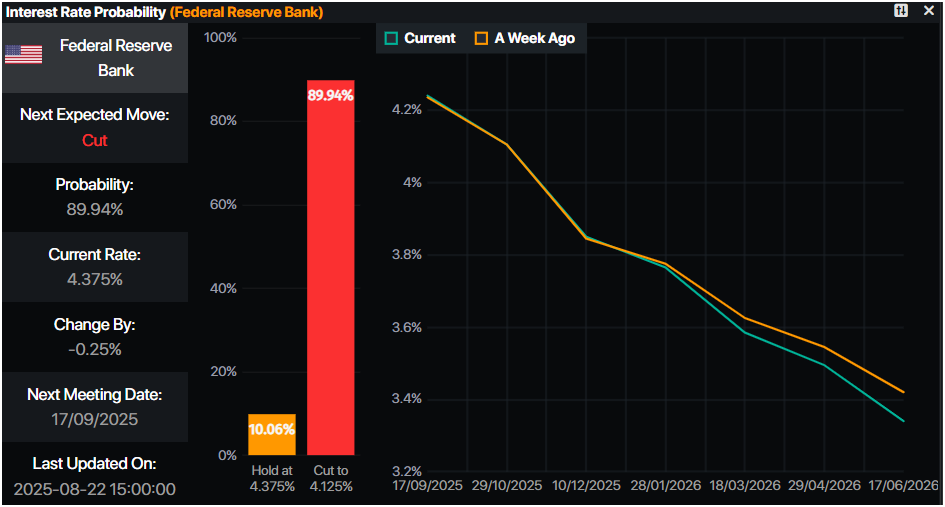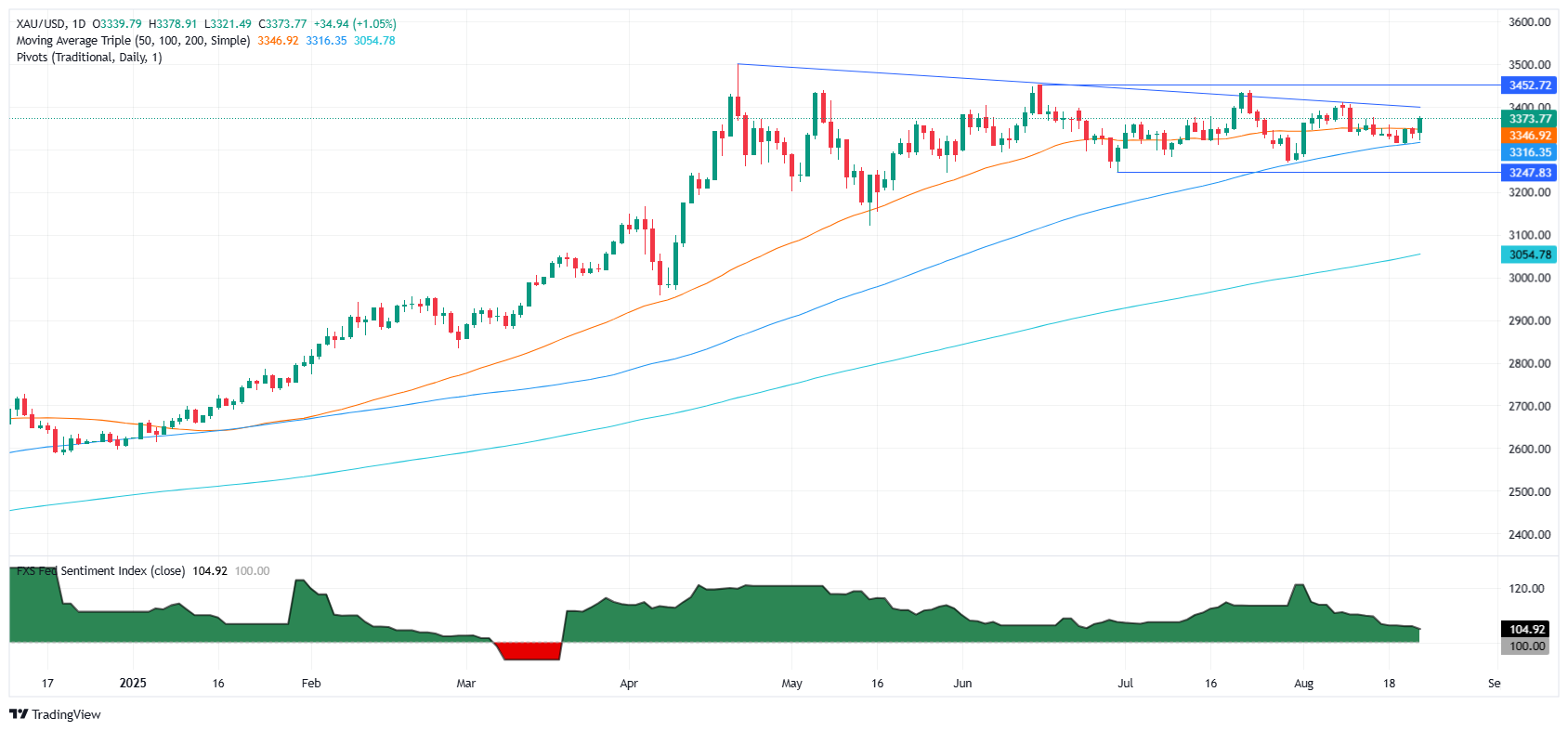Gold climbs as Powell flags rising labor risks, dovish Fed tilt
- Gold prices rallied sharply after Powell’s dovish tone highlighted employment risks despite persistent upside risks to inflation.
- Traders priced in a 90% probability of a 25 basis-point Fed cut, with key data still ahead before September.
- Next week’s US docket includes Durable Goods, GDP, and the Fed’s preferred inflation gauge, the Core PCE Price Index.
Gold prices continue to trend higher on Friday after the Federal Reserve (Fed) leaned dovish, as commented by the Fed Chair Jerome Powell, who said that “downside risks to the labor market are rising.” XAU/USD trades at $3,371 after hitting a daily low of $3,321.
The day arrived and Powell hinted that there’s a “reasonable base case” to think that tariffs would create a “one-time” increase in prices. Nevertheless, he acknowledged that risks to inflation are tilted to the upside and risks to employment to the downside, a “challenging situation.”
After his remarks, Bullion prices initially soared towards the $3,350 area before resuming to the upside, heading to a daily high of $3,378 before retreating somewhat to current price levels.
Market participants had priced in a 90% chance that the Federal Reserve will cut 25 basis points (bps) from its main reference rate, according to Prime Market Terminal. However, there are two inflation prints left and the following Nonfarm Payrolls report on September 5.

Source: Prime Market Terminal
After Powell’s speech, Cleveland Fed President Beth Hammack said that she heard that Powell is open-minded about the policy outlook, and she reiterated her stance to get inflation back to target.
Next week, the US economic docket will feature Fed speeches, Durable Goods Orders, CB Consumer Confidence, GDP figures, Initial Jobless Claims, and the Fed’s preferred inflation gauge measure, the Core Personal Consumption Expenditures (PCE) Price Index.
Daily digest market movers: Gold boosted by speculation of September rate cut
- Following Powell’s remarks, US Treasury yields tumbled, flattening the yield curve. The 10-year Treasury note is down nearly seven basis points at 4.261%. US real yields —which are calculated from the nominal yield minus inflation expectations— are down seven bps at 1.871% at the time of writing.
- The US Dollar Index (DXY), which tracks the performance of the USD against a basket of six currencies, drops more than 1% to 97.55.
- Fed Chair Powell said, “The baseline outlook and the shifting balance of risks may warrant adjusting our policy stance.” He added that “the stability of the unemployment rate and other labor market measures allows us to proceed carefully.”
- Cleveland’s Fed Beth Hammack added that the Fed is a small distance away from the neutral rate and that the “Fed needs to be cautious about any move to cut rates.” She expects a rise in inflation and in the unemployment rate.
Technical outlook: Gold price surges towards $3,400
Gold price has risen sharply, but it remains shy of testing the $3,400 mark. Bulls emerged on Powell’s remarks but remain cautious as geopolitical risk had de-escalated following upbeat news at the beginning of the week, regarding Russia and Ukraine.
If XAU/USD climbs past $3,400, the next resistance would be the June 16 high of $3,452, ahead of the record high of $3,500. On the flipside, the $3,300 figure would be the first demand zone.
Conversely, if Bullion retraces, it could halt its stop at the 50-day Simple Moving Average (SMA) at around $3,350. On further weakness, the 20-day SMA at $3,345 is up next, followed by the 100-day SMA at $3,309.

Gold FAQs
Gold has played a key role in human’s history as it has been widely used as a store of value and medium of exchange. Currently, apart from its shine and usage for jewelry, the precious metal is widely seen as a safe-haven asset, meaning that it is considered a good investment during turbulent times. Gold is also widely seen as a hedge against inflation and against depreciating currencies as it doesn’t rely on any specific issuer or government.
Central banks are the biggest Gold holders. In their aim to support their currencies in turbulent times, central banks tend to diversify their reserves and buy Gold to improve the perceived strength of the economy and the currency. High Gold reserves can be a source of trust for a country’s solvency. Central banks added 1,136 tonnes of Gold worth around $70 billion to their reserves in 2022, according to data from the World Gold Council. This is the highest yearly purchase since records began. Central banks from emerging economies such as China, India and Turkey are quickly increasing their Gold reserves.
Gold has an inverse correlation with the US Dollar and US Treasuries, which are both major reserve and safe-haven assets. When the Dollar depreciates, Gold tends to rise, enabling investors and central banks to diversify their assets in turbulent times. Gold is also inversely correlated with risk assets. A rally in the stock market tends to weaken Gold price, while sell-offs in riskier markets tend to favor the precious metal.
The price can move due to a wide range of factors. Geopolitical instability or fears of a deep recession can quickly make Gold price escalate due to its safe-haven status. As a yield-less asset, Gold tends to rise with lower interest rates, while higher cost of money usually weighs down on the yellow metal. Still, most moves depend on how the US Dollar (USD) behaves as the asset is priced in dollars (XAU/USD). A strong Dollar tends to keep the price of Gold controlled, whereas a weaker Dollar is likely to push Gold prices up.

